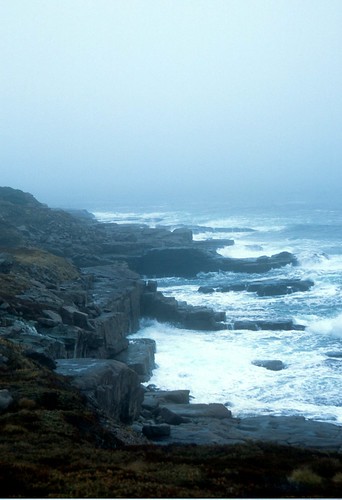 Experts on the sea level rise triggered by climate change have long known that it will proceed faster in some places than others. The mid-Atlantic coast of the U.S. is one of them, and the reason — in theory, anyway — is that global warming should slow the flow of the Gulf Stream as it moves north and then east toward northern Europe.
Experts on the sea level rise triggered by climate change have long known that it will proceed faster in some places than others. The mid-Atlantic coast of the U.S. is one of them, and the reason — in theory, anyway — is that global warming should slow the flow of the Gulf Stream as it moves north and then east toward northern Europe.Now there’s a smoking gun that appears to validate the theory. A study in the February Journal of Geophysical Research: Oceans ties the measured acceleration of sea level rise in this area to a simultaneous slowdown in the flow of the Gulf Stream. “There have been several papers showing (sea level rise) acceleration,” said lead author Tal Ezer, of Old Dominion University’s Center for Coastal Physical Oceanography. “This new paper confirms the hypothesis for why it’s happening.”
When higher seas are pushed ashore by a major event like Hurricane Sandy, the impact can be devastating. Even without faster-than-average sea level rise, America’s East Coast would be at high risk. On average, scientists have projected that the oceans should rise by about 3 feet by 2100, inundating low-lying land, contaminating water supplies and undermining roads, airports, port facilities and power plants. Add the storm surges that come with hurricanes and other severe weather, and the danger gets even worse. A worldwide average of 8 inches of sea level rise since 1900 has already put millions of Americans at risk; 3 feet more will greatly multiply that risk; and the even higher levels that Americans could see will be a very bitter icing on top of that already unpleasant cake.
The slowing of the Gulf Steam is not the only reason the U.S. coast will see higher sea level than the world average in coming decades, Ezer said. In some places, the land itself is slowly sinking as it readjusts to the disappearance of continental ice sheets more than 10,000 years ago.
But that process can’t explain why sea level rise should actually be speeding up, as a report in the Journal of Coastal Research documented in October 2012. Another study, which appeared in Nature Climate Change in June 2012, showed the same thing, and suggested that a Gulf Stream slowdown could be a contributing factor. Ezer’s own paper in Geophysical Research Letters in September 2012, documented the phenomenon in Chesapeake Bay, and once again, suggested the Gulf Stream’s possible role.
Storm surge from Hurricane Sandy paralyzed the Hoboken, N.J., PATH system in last October's storm. What makes this new study different is that it includes actual measurements of the Gulf Stream’s flow, from instruments mounted on underwater cables that stretch across the Florida Strait. It also uses satellite altimeter data to document changes in the height of the ocean from one side of the Gulf Stream to the other. Normally, the northeasterly flow of the stream literally pulls water away from the coast.
“It keeps coastal sea level a meter or a meter and a half lower than the rest of the ocean,” Ezer said. In recent years, however, the satellites show that the midpoint of the Gulf Stream doesn’t have as high an elevation as it used to, and that the edges aren’t quite as low — again, evidence that the stream itself is starting to slow down.
Theory says this is just what should be happening. Ordinarily, the Gulf Stream brings warm surface water from the tropics up along the U.S. coast, and then across to the eastern North Atlantic, where it cools and sinks to the bottom of the sea. The cold bottom water then flows south to the tropics, where it gradually warms, rises to the surface, and begins flowing north again. This constant flow, which meanders through all of the world’s oceans is sometimes called the global ocean conveyor belt, and the section that operates in the North Atlantic is called the Atlantic Meridional Overturning Circulation.
In a warming world, two things happen to throw a monkey wrench into the conveyor belt. First, melting ice, mostly from Greenland, dilutes the surface waters where the Gulf Stream reaches its northernmost extent. Since fresh water is less dense than salty water, the water has a more difficult time sinking to begin its journey southward. Second, the surface water is warmer than it used to be, and since warm water is less dense than cold water, this just adds to the problem.
Put the two together and you start to jam up the works, with the result that the whole conveyor belt slows down. And the water along the Atlantic coast of the U.S. begins to rise at an accelerating rate. While scientists expect sea level to rise by about 3 feet over the next 90 years or so, in places like New York City and Norfolk, Va., it could be significantly more. New York, where sea level is already a foot higher than it was in 1900, was just reminded of what happens when higher seas are pushed ashore by a major event like Superstorm Sandy.
Add several more feet of sea level to that destructive equation, and the potential destruction is difficult to imagine.
Source: Climate Central
Image courtesy of scjody via Flickr (CC BY-SA 2.0)
